15 Brand perception survey questions and examples (+ template)

- How does a brand perception survey help your business?
- Why are brand health surveys important?
- Brand perception survey question types
- When to use brand perception surveys
- Who should you send a brand survey to?
- Who should you ask brand survey questions?
- 15 Brand perception survey questions
- Brand perception survey tips and best practices for quality insights
- How does brand awareness compare to other brand metrics?
- 3 Brand survey examples for marketers who understand their customers
- Brand perception survey template
- Ready to get started with your brand perception survey?
- Brand perception survey FAQs
Gain a better understanding of your company’s reputation using our brand perception survey or build your own using these 15 sample questions and examples.
Do you think that Apple is cool, Yakult is healthy, or Dyson is clever? We all have ideas about brands and what they represent – it’s known as brand perception.
How customers perceive brands is key for knowing where to focus branding, customer support, taking important branded social stances, and even marketing efforts. This means you need to do brand perception surveys.
But what exactly are they, and how can you conduct your own?
Here is a quick list of 15 brand perception survey questions:
- What type of products/services does [your brand] sell?
- How would you describe [your brand] to a friend?
- Which (if any) of the following traits do you associate with [your brand]?
- What emotions do you feel when you think about [your brand]?
- Who do you think [your brand] is aimed at?
- Which (if any) of the following messages do you associate with [your brand]?
- Where do you think [your brand] sits in the market?
- What do you think about [your brand]’s pricing?
- What do you think about [your brand]’s advertising?
- What words would you use to describe [your brand]’s packaging?
- What [your brand] product/service have you used?
- What is the first brand you think of when you think of [your brand’s product/service type]?
- How did you hear about [brand] in the first place?
- What negative experiences have you had with [your brand]?
- What’s your experience with [your brand]’s customer service?
How does a brand perception survey help your business?
A brand perception survey is a set of questions that help understand how customers, users, stakeholders, and others what comes to mind when they see or hear from your brand:
- How does the brand make them feel?
- What things do they associate with the brand?
As well as other important information to help you understand whether or not your marketing messaging and brand identity are matching what your customers are concluding.
There are many possible questions that you could ask to better understand what your customers’ image of your brand is, especially if you are sending a survey to an international audience.
Before exploring the questions that will provide you brand insights, let’s first have a look at why it’s important to know your customer’s brand perception.
If you want to learn more about the difference between surveys and questionnaires (and which is right for you), read our guide.
Why are brand health surveys important?
It’s important for any brand to understand how customers and prospects perceive it. When you measure brand perception, you’re realising things about your brand development that you might not even know about.
For example:
- What underlying feelings do customers get from seeing your logo?
- How easily can they recall your brand?
- Do they trust your brand?
- What level of brand loyalty do they have?
- What brand qualities do your customers associate with your brand?
- How do customers feel about your brand and its competitors?
Knowing all of this information will help you improve your marketing strategy and branding efforts so that your customers are getting the messages you’re trying to communicate.
You might be wondering when it’s best to run a perception survey to inform your brand purpose. Is it something for the early stages of market research? Or perhaps is something to do right after you launch a marketing campaign?
Let’s find out.
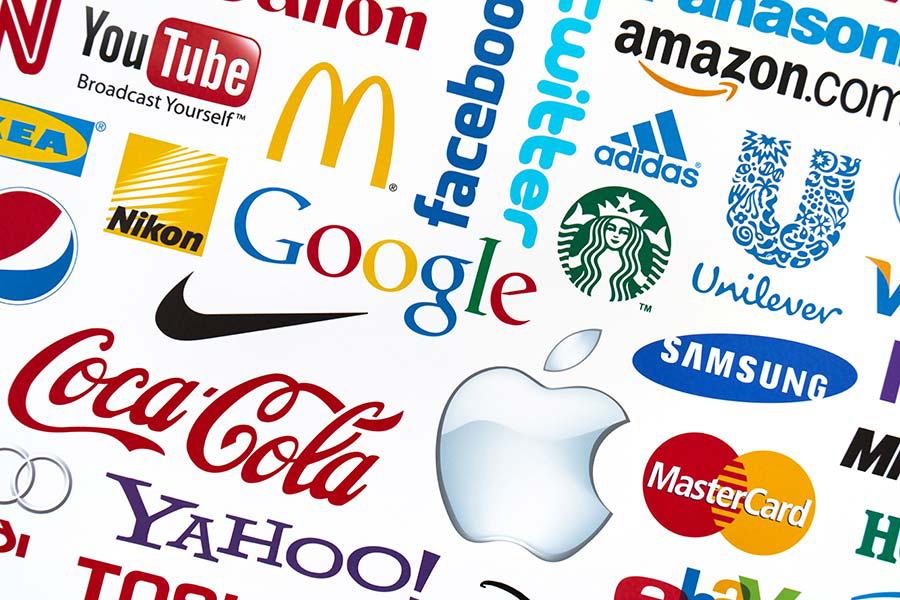
Brand perception survey question types
To get the most useful results from your brand perception survey, you should design it with a variety of question types. The question-and-answer format you choose will dictate whether the data you collect is ‘quantitative’ or ‘qualitative’.
- Quantitative responses are those that can be reported as a number, i.e. 62.8% of respondents selected answer A.
- Qualitative responses are those given to open-text questions. People answer in their own words, and no predefined answers are provided.
Having a mixture of both types will give you the best understanding of your brand perception. Quantitative questions let you set perimeters so you can measure perceptions around specific traits or receive responses in a standardised way that’s easy to analyse.
Meanwhile, qualitative questions allow you to collect unbiased feedback and provide colour and context around the numeric data.
You can use the following question types for your surveys with Attest:
- Single choice
- Multiple choice
- Ranking – i.e. ask consumers to rank traits in order of how strongly they associate them with your brand
- Scales – i.e. ask people to select how much they agree or disagree with a statement about your brand
- Open text
- Net Promoter Score – i.e. ask respondents how likely they are to recommend your brand to friends on a scale of 1-10 in order to get your NPS
When to use brand perception surveys
It makes sense to run a brand perception study once your brand has been out in the market long enough to achieve reasonable brand awareness. After all, if most people have never actually heard of your brand, they’re not going to have any opinions about it.
Once you reach a stage where you’re running national brand awareness campaigns and have good distribution, you can start asking people what they think.
It’s a great idea to run a brand perception survey prior to planning any new marketing strategy so that you have a clear idea of existing strengths and weaknesses.
It’s also a useful project to undertake before going out for funding or approaching strategic partnerships (see our list of brand extension examples.) It allows you to prove to stakeholders outside of your business how valuable your brand is – and the type of consumers who have an affinity with it.
If you don’t have the time or capacity to run a brand perception survey, you may wish to outsource this to a brand tracking agency.
Who should you send a brand survey to?
One thing brand managers often believe is that they should ask existing customers what they think about their brand.
While it is very important to know what they think, a reliable brand perception survey needs to go further than this. Bear in mind that existing clients have already experienced your marketing communications, liked what they saw, and decided to buy.
But what about the people who decided not to buy?
Arguably, it’s those people who have the most valuable insights because something about their experience has put them off and made them think, ‘this brand is not for me’. And if those are people within your target audience, this could be a cause for concern.
Because of this, you should always speak to customers and non-customers when running a brand perception survey (and with other types of research, like customer profiling).
You can do this with ease by using a self-service market research company like Attest, a brand tracking tool that can give you access to 150+ millionm people in 59 countries.
Using the Attest survey platform, you can select respondents according to a number of different demographic filters, so you’re only asking people who fall into your target market.
As a first step, you can begin your survey with a qualifying question to make sure only those respondents who are actually aware of your brand carry on with the survey. A qualifying question might look like this:
Q. Which of the following brands have you heard of, if any?
- A. Your brand
- B. Competitor
- C. Competitor
- Etc…
Hot tip: (Remember to randomize your answer options so as not to bias your respondents’ choices.)
Those who answer Your brand will be qualified into the survey and shown the next question(s). Those who are unaware of your brand will be thanked for their time and exited, meaning you don’t have to waste money on responses that aren’t useful.
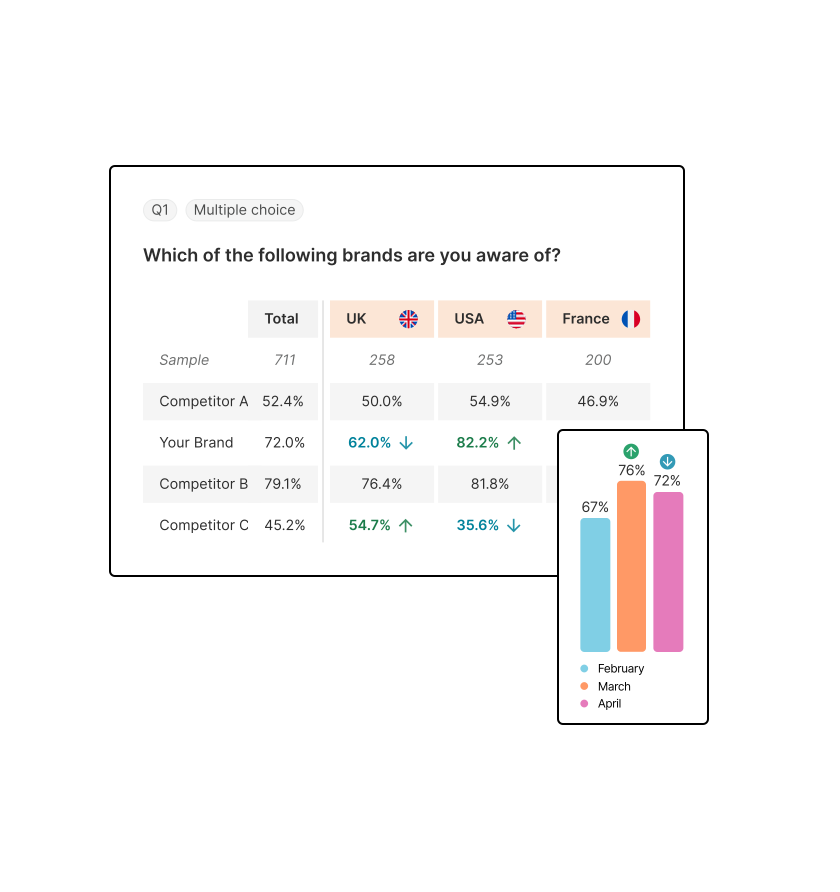
Track your brand (with expert help!)
Make smarter decisions for your brand using Attest for fast, accurate insights and designated support from our in-house experts
Speak to the expertsWho should you ask brand survey questions?
First up, it’s important to find out if survey respondents are already customers or not so you can differentiate their answers.
You should include a question which asks if they have ever purchased your brand before. But rather than posing a simple yes or no question, you should dig a little deeper to understand how much experience they’ve had with your brand.
A question might look like this:
Q. How often do you typically purchase [your brand]?
- Weekly
- Monthly
- Every 2-6 months
- Every 7-12 months
- Less frequently than once a year
- I’ve only purchased once before
- I’ve never purchased before
The answer scale you include will depend on the products in your sector (i.e. people will buy soft drinks more frequently than they buy clothes). You might want to use a brand tracking survey template for added insights.
You may also want to use routing to direct respondents to different questions based on how they answered, for example, to ask those who have purchased your brand before about their experiences.
Here are some other key questions for brands to ask their audience.

15 Brand perception survey questions
1. What type of products/services does [your brand] sell?
Why? The aim here is to find out if the respondent can correctly associate your brand name to what you do.
This gives you an indication of the level of brand awareness that you have i.e. have they just heard of your company name or do they actually understand the nature of your business? Can they identify your product, services and solutions?
2. How would you describe [your brand] to a friend?
Why? Asking how a respondent would describe you to friends lets you hear in their own words what they think your brand offers and represents.
Is your proposition easy or difficult for them to sum up? What language do they use? Look for the most frequently repeated words or phrases. Ways to visualise this data include putting it into a word cloud.
3. Which (if any) of the following traits do you associate with [your brand]?
Why? You’ll include a list of brand attributes you believe your brand possesses mixed with some conflicting ones.
For example, ‘modern’ and ‘old-fashioned’. Do people select the traits you hope for? Which ones come out on top? You may discover that some desired traits are less dominant than others, showing you where messaging needs strengthening.
4. What emotions do you feel when you think about [your brand]?
Why? Traits are the qualities that your brand has, but emotions are the feelings that your brand stirs in others.
It’s important to try to influence both with your marketing if you want to succeed because purchase decisions are often made in the heart and not in the head.
5. Who do you think [your brand] is aimed at?
Why? If you’ve been targeting a particular demographic, with marketing designed to appeal to them, this question will let you know how well you’re doing.
Do the audience you’re surveying realise the brand is aimed at them or is there a misstep here?
6. Which (if any) of the following messages do you associate with [your brand]?
Why? This is where you can test awareness of your brand tagline, slogan or messaging from a specific campaign.
You can also include messaging from competitors to understand if there’s any confusion between your brand and others. How differentiated is your brand’s voice in the crowd?
7. Where do you think [your brand] sits in the market?
Why? You can provide a scale from ‘high-end’ to ‘low-end’ to see if you are projecting the right brand image.
Do consumers consider your brand mid-range, even though you’re aiming for prestige? This indicates that you need to tweak things like your pricing, packaging and store placement.
Try our brand tracker survey template to find out what customers really think of your brand image, or read our brand tracking guide.
8. What do you think about [your brand]’s pricing?
Why? Asking your target demographic if they perceive your brand as expensive, reasonable or cheap lets you find out if you’ve pitched your pricing right.
You can also ask respondents to rate the perceived quality of your brand to see if there’s any mismatch between quality and price – i.e. people think your brand is too expensive because it’s low quality or they think it is high quality at a cheap price.
9. What do you think about [your brand]’s advertising?
Why? This question lets you understand if you’re hitting the right mark with your marketing.
You can tailor the answers to find out if people like or dislike it, what traits they associate with your marketing or even how memorable they think it is. You can also expand the process by carrying out creative testing and copy testing before running your next campaign to make sure it’s on-brand.
10. What words would you use to describe [your brand]’s packaging?
Why? By embedding imagery of your packaging into your survey, you can get feedback on its design.
Does your packaging reflect your desired brand traits? Is there anything about it that’s out of alignment? To explore perceptions about your packaging in more detail, consider carrying out a packaging design testing survey.
It’s worth noting that you can also ask any of these questions in respect to a competitor’s brand, not just your own. This allows you to make direct comparisons between how your brand is perceived and how your competitors are perceived and can add extra depth to your market research.
Looking for some real-life packaging testing examples? Here are some top brands who used consumer insights to test their beverage branding ideas.
11. What [your brand] product/service have you used? How did you like it?
Why? This question helps you know which of your respondents have used your products.
This is an important classification step because it allows you to understand who your customers are and which products define their perception of your brand.
You could realise with this question that those who use product X have a much more positive perception than those who use product Y. This will allow you to investigate where the problem is and solve it properly.
12. What is the first brand you think of when you think of [your brand’s product/service type]?
Why? This question, although more in line for a brand awareness survey, helps you see if your customers can immediately relate your brand to your product type.
After all, you don’t want people to only think of your brand when they see an advertisement. No. You want them to immediately think of your brand when they’re looking for your product or service category.
13. How did you hear about [brand] in the first place?
Why? This question allows you to understand how your customers came to your brand.
This, in turn, will tell you whether they had a positive impression from the first moment because they were recommended by a friend, or whether they found you thanks to your successful content strategy. It can even tell you if they first heard about you because they were looking for a solution at a certain price point.
All the information you can gather with this question will help you understand how customers perceive you and how your marketing efforts and sales cycle are working.
14. What negative experiences have you had with [your brand]?
Why? By asking this question you’ll be able to understand what circumstances can be harming your brand’s perception.
It helps you to understand how resilient your brand is when you consider the severity of the negative experience and the impact on your brand’s perception.
15. What’s your experience with [your brand]’s customer service?
Why? Customer experience is a big part of brand perception.
By understanding how they have directly interacted with the brand and its customer service, you’ll be able to gather valuable insight into your customers’ perception of your brand.
Learn how customers perceive your brand with one survey
Our brand perception survey template is ready to give you in-depth insights on how key demographics see your brand.
Send your brand perception surveyBrand perception survey tips and best practices for quality insights
Incorporating a variety of question types into your brand perception survey will not only give you richer data, but it will also make it more engaging for your respondents.
You can also maximize engagement by keeping your survey to between 10-12 questions – so it takes no more than five minutes to complete.
Let people know at the beginning how long the survey is likely to take. This will help to manage their expectations and maintain their attention. You want respondents to give your questions proper consideration rather than starting to rush through them.
Attest lets you add message cards throughout your survey to break it into sections and keep respondents tuned-in.
Include answer options like ‘don’t know’, ‘N/A’ or ‘none’ to cater for people who are less familiar with your brand and will therefore be unable to truthfully answer some questions. This will help to maintain your data quality.
Finally, before you hit ‘go’ on your brand perception survey, check that it’s well-designed and makes sense to the average person by having someone outside of your team (or even your organisation) demo it.
If you’re struggling to find the right questions to ask and customers to answer, you might need the help of a dedicated customer insights platform. We’ve compiled a list of the top Qualtrics alternatives for sending brand perception surveys.
How does brand awareness compare to other brand metrics?
Brand perception is just one piece of the broader brand measurement puzzle. To get a full picture of your brand’s impact, it’s essential to understand how it relates to other key brand metrics.
Brand awareness vs. brand equity
Brand awareness and brand equity are closely related but have some important differences.
Brand awareness refers to how familiar consumers and customers are with your brand – essentially whether they recognise your name, logo and products.
Brand equity is the value your brand holds in the minds of consumers and customers. Brand equity is shaped over time by people’s awareness and perception of your brand.
Where it’s important to separate the two is that your brand can have high brand awareness, but low brand equity. If people recognize your brand but don’t associate it with positive qualities and real value, the value your brand has – its equity – will be low.
Brand awareness vs. brand perception vs. brand identity
It’s important to know the sometimes subtle differences between perception, awareness and identity, so that you can make smarter choices about how you build your brand.
Here’s a brief comparison of brand perception vs. brand awareness vs. brand identity:
| Concept | Definition | What influences this |
| Brand awareness | The extent to which people recognize and recall your brand. | Visibility and recognition |
| Brand perception | How consumers view your brand based on experiences, messaging, and reputation. | Consumer opinions and associations |
| Brand identity | The elements that define how you present your brand, such as logo, colors, and tone of voice. | Visual and verbal branding |
3 Brand survey examples for marketers who understand their customers
Want to see what a brand perception survey actually looks like? Check out these interactive brand survey examples below. You can play around with the demographic filters to see how it changes the results.
Smartphone perceptions survey
Here’s a great example of a survey to US consumers about their perceptions of smartphone brands.
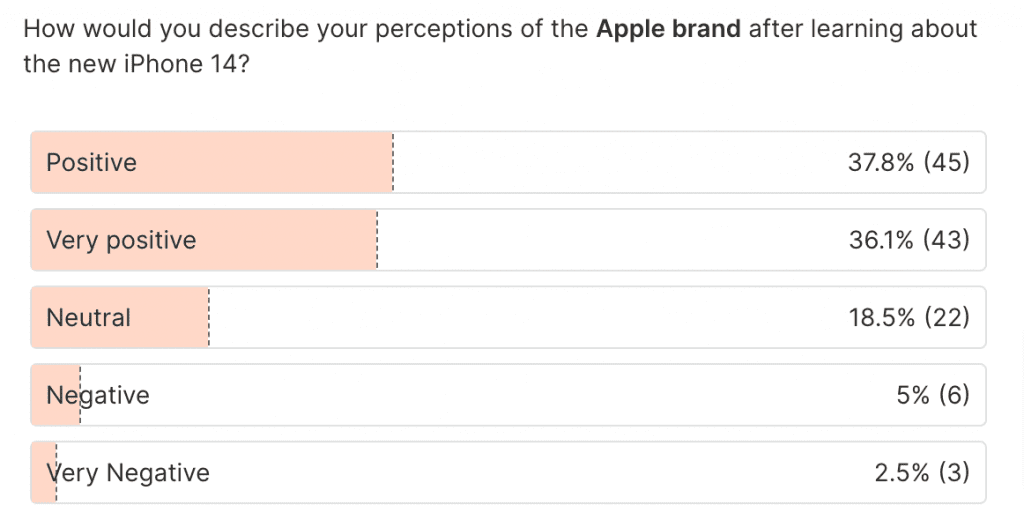
Vitamins, minerals and supplements awareness survey
This survey example shows UK consumers’ awareness of various vitamin brands.
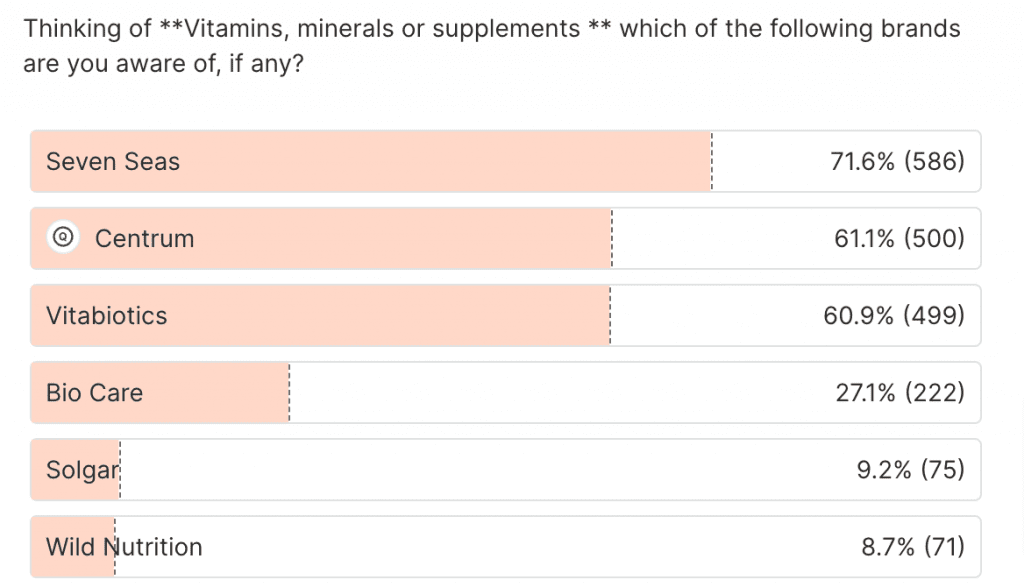
Almond Breeze almond milk
Here you can see people’s purchase intent from this example survey to UK consumers about plant-based milk brands.
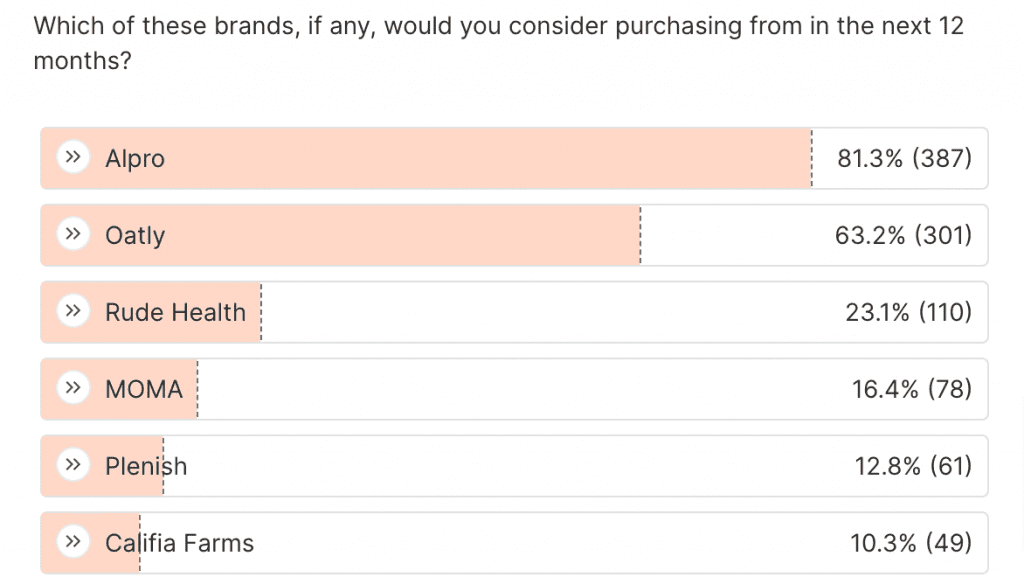
Brand perception survey template
If you’re looking to get started quickly, we’ve created a brand perception survey template, pre-populated with the key questions to uncover what people think about your brand. The template can be easily edited so you can adapt it to your needs.
Ready to get started with your brand perception survey?
With Attest, you can be up and running in no time at all. Book an intro to the platform to have one of our research experts talk you through our easy-to-use survey builder.
We’re already working with companies like Unilever, Ocado and Wise, helping them manage their brands more effectively. Start taking control of your brand by launching a brand perception survey today.
Choose the best brand tracking platform for you
Read our list of the top 11 brand tracking tools and their features to decide which is best for your needs.
Get the listBrand perception survey FAQs
Brand perception is the term for a consumer’s thoughts and feelings about a particular brand—it’s the sum of how they feel about a product or service.
By measuring and tracking consumer perception of your brand, you can tailor your marketing strategy to fit their needs, stay ahead of market trends and beat competitors.
To track your brand perception, scheduling a demo with Attest’s team of market research experts who’ll show you the best ways to improve and maintain your brand perception using in-depth surveys.
Insightful brand perception survey questions include:
1. How often do you typically purchase [your brand]?
2. How would you describe [your brand] to a friend?
3. What emotions do you feel when you think about [your brand]?
4. What words would you use to describe [your brand]’s packaging?
To get started tracking your brand perception, try our ready-to-go survey templates.
Measuring brand perception is simple as long as your survey questions are worded correctly and do not mislead consumers.
Keep language neutral in order to correctly reveal the underlying feelings consumers have about your brand, product and services.
To make the process easier, you may want to invest in a brand tracking platform like Attest in order to benefit from ready-to-go templates, expert support, and data that’s triple-checked for quality that makes brand perception tracking digestible.
Tell us what you think of this article by leaving a comment on LinkedIn.
Or share it on:
